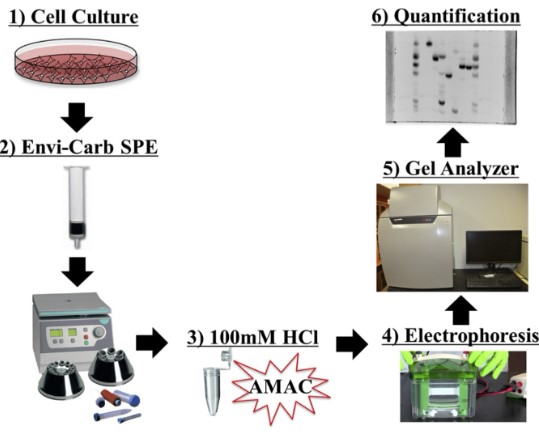Sugar Nucleotide Analysis Service
High-quality Sugar Nucleotide Analysis at Creative Biolabs
Sugar nucleotides are the substrates required for the synthesis of sugar chains. They transfer sugar groups to acceptor molecules through glycosyltransferases to form complex sugar chain structures. Moreover, sugar nucleotides participate in the modification process of glycoproteins, such as glycosylation, sulfation, etc. These modifications have an important impact on the structure and functions of glycoproteins, so analyzing sugar nucleotides can help understand the mechanism of glycosylation modifications in biological systems, physiological functions, and mechanisms of disease occurrence.
Creative Biolabs has an industry-leading Analysis Platform. Our scientists have extensive experience in sugar nucleotide analysis and provide custom analysis services according to client needs. Our analysis process mainly includes the following contents:
Extraction of sugar nucleotides
We extract sugar nucleotides from cell or tissue samples, treat the sample using an appropriate method (such as sonication or chemical lysis), and mix it with an extraction buffer (such as a chloroform-methanol mixture). Then, steps such as homogenization and centrifugation are used to promote the release of sugar nucleotides.
Purification of sugar nucleotides
We use solid phase extraction (SPE) columns to purify the extracted samples to remove impurities. Moreover, chromatographic techniques are used to separate and enrich the extracted sugar nucleotides.
Detection of sugar nucleotides
Uridine diphosphate (UDP)-sugar is the largest nucleotide sugar, and its structure shows strong acidity and hydrophilicity. We provide various analytical methods to analyze sugar nucleotides according to their structural properties.
-
We combine ion-pair high-performance liquid chromatography (IP-HPLC) with a variety of detectors (e.g. UV detector, mass spectrometry(MS)) to analyze highly hydrophilic compounds such as nucleotides and sugar nucleotides.
-
For acidic sugar nucleotides, we use silica groups bonded with quaternary ammonium functional groups as the stationary phase and use high-performance anion exchange chromatography (HPAEC) for analysis. This method provides efficient separation of sugar nucleotides with high sensitivity.
-
Sugar nucleotides are extremely hydrophilic and their phosphate groups are negatively charged under neutral or alkaline conditions, so we use hydrophilic interaction chromatography (HILIC) technology to analyze sugar nucleotides. The mobile phase usually consists of a high content of organic solvent (such as acetonitrile or methanol) and a small amount of buffer salt (such as ammonium acetate). By adjusting the composition and pH value of the mobile phase, we effectively separate different types of sugar nucleotides so that they are retained on the column to varying degrees.
-
Intracellular levels of nucleotides and sugar nucleotides have a direct impact on post-translational modifications of therapeutic protein products. We have developed a reproducible and robust analytical system to separate and quantify nucleotides and sugar nucleotides in cell extracts via capillary electrophoresis (CE) and UV detector at 260nm.
In addition, we also provide Sialic Acid, Monosaccharide, and Glycosaminoglycan Analysis services.
 Fig.1 The workflow of sugar nucleotide analysis.
Fig.1 The workflow of sugar nucleotide analysis.
Publication
Technology: SPE and fluorophore-assisted carbohydrate electrophoresis (FACE)
Journal: MethodsX
IF: 2.19
Published: 2016
Results: The authors developed a simple method for efficient purification and quantification of sugar nucleotides. They used SPE chromatography to purify sugar nucleotides and then used FACE to analyze multiple sugar nucleotides. This technology was simple to operate and could run multiple samples at the same time, which had obvious operational and analytical advantages.
 Fig.2 SPE-FACE-based analysis process of sugar nucleotides.1, 2
Fig.2 SPE-FACE-based analysis process of sugar nucleotides.1, 2
Advantages
-
Professional technical teams: We have experienced and highly specialized technical teams who have extensive experience in sugar nucleotide analysis and can handle samples from different sources and types and solve complex problems.
-
Diversified analytical techniques: We use a variety of analytical techniques to analyze sugar nucleotides, such as HPLC, MS, CE, etc.
-
High efficiency and accuracy: We focus on analysis efficiency and accuracy to ensure the accuracy and reliability of sugar nucleotide analysis results.
Application
-
Research on glycosyl-modified proteins: Analysis of sugar nucleotides reveals the type and degree of glycosyl modifications on proteins, helping to understand protein functions and their association with diseases.
-
Drug design: Sugar nucleotides play an important role in drug synthesis and biosynthetic pathways, and the analysis of sugar nucleotides can help in drug design and evaluation.
-
Bioengineering: In the field of bioengineering, sugar nucleotide analysis is used to optimize the protein sugar modification process to improve the functions and properties of the product.
Creative Biolabs is equipped with a variety of professional analysis equipment. We efficiently complete the analysis tasks of sugar nucleotides and provide clients with quality services. We are committed to becoming your trustworthy analysis partner. Please contact us if you need more analysis details.
References
-
Barnes, Jarrod, et al. "Isolation and analysis of sugar nucleotides using solid phase extraction and fluorophore assisted carbohydrate electrophoresis." MethodsX 3 (2016): 251-260.
-
Under Open Access license CC BY 4.0, without modification.
For Research Use Only.
Related Services

 Fig.1 The workflow of sugar nucleotide analysis.
Fig.1 The workflow of sugar nucleotide analysis.
 Fig.2 SPE-FACE-based analysis process of sugar nucleotides.1, 2
Fig.2 SPE-FACE-based analysis process of sugar nucleotides.1, 2



